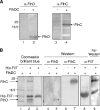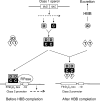FliT acts as an anti-FlhD2C2 factor in the transcriptional control of the flagellar regulon in Salmonella enterica serovar typhimurium
- PMID: 16952964
- PMCID: PMC1595477
- DOI: 10.1128/JB.00799-06
FliT acts as an anti-FlhD2C2 factor in the transcriptional control of the flagellar regulon in Salmonella enterica serovar typhimurium
Abstract
Flagellar operons are divided into three classes with respect to their transcriptional hierarchy in Salmonella enterica serovar Typhimurium. The class 1 gene products FlhD and FlhC act together in an FlhD(2)C(2) heterotetramer, which binds upstream of the class 2 promoters to facilitate binding of RNA polymerase. Class 2 expression is known to be enhanced by a disruption mutation in a flagellar gene, fliT. In this study, we purified FliT protein in a His-tagged form and showed that the protein prevented binding of FlhD(2)C(2) to the class 2 promoter and inhibited FlhD(2)C(2)-dependent transcription. Pull-down and far-Western blotting analyses revealed that the FliT protein was capable of binding to FlhD(2)C(2) and FlhC and not to FlhD alone. We conclude that FliT acts as an anti-FlhD(2)C(2) factor, which binds to FlhD(2)C(2) through interaction with the FlhC subunit and inhibits its binding to the class 2 promoter.
Figures




Similar articles
-
The DnaK chaperone machinery converts the native FlhD2C2 hetero-tetramer into a functional transcriptional regulator of flagellar regulon expression in Salmonella.Mol Microbiol. 2006 Feb;59(4):1327-40. doi: 10.1111/j.1365-2958.2005.05016.x. Mol Microbiol. 2006. PMID: 16430704
-
The interaction dynamics of a negative feedback loop regulates flagellar number in Salmonella enterica serovar Typhimurium.Mol Microbiol. 2010 Dec;78(6):1416-30. doi: 10.1111/j.1365-2958.2010.07415.x. Epub 2010 Oct 15. Mol Microbiol. 2010. PMID: 21143315
-
Interaction of the atypical prokaryotic transcription activator FlhD2C2 with early promoters of the flagellar gene hierarchy.J Mol Biol. 2002 Aug 9;321(2):185-99. doi: 10.1016/s0022-2836(02)00600-9. J Mol Biol. 2002. PMID: 12144778
-
EAL domain protein YdiV acts as an anti-FlhD4C2 factor responsible for nutritional control of the flagellar regulon in Salmonella enterica Serovar Typhimurium.J Bacteriol. 2011 Apr;193(7):1600-11. doi: 10.1128/JB.01494-10. Epub 2011 Jan 28. J Bacteriol. 2011. PMID: 21278297 Free PMC article.
-
Genetic control of the bacterial flagellar regulon.Curr Opin Genet Dev. 1991 Oct;1(3):319-23. doi: 10.1016/s0959-437x(05)80294-1. Curr Opin Genet Dev. 1991. PMID: 1840887 Review.
Cited by
-
Lessons in Fundamental Mechanisms and Diverse Adaptations from the 2015 Bacterial Locomotion and Signal Transduction Meeting.J Bacteriol. 2015 Oct;197(19):3028-40. doi: 10.1128/JB.00384-15. Epub 2015 Jul 20. J Bacteriol. 2015. PMID: 26195592 Free PMC article. Review.
-
Mathematical model of flagella gene expression dynamics in Salmonella enterica serovar typhimurium.Syst Synth Biol. 2015 Jun;9(1-2):19-31. doi: 10.1007/s11693-015-9160-3. Epub 2015 Feb 4. Syst Synth Biol. 2015. PMID: 25972986 Free PMC article.
-
Switching off Bacterial Flagellar Biogenesis by YdiU-Mediated UMPylation of FlhDC.mBio. 2022 Jun 28;13(3):e0024922. doi: 10.1128/mbio.00249-22. Epub 2022 May 9. mBio. 2022. PMID: 35532215 Free PMC article.
-
Analysis of factors that affect FlgM-dependent type III secretion for protein purification with Salmonella enterica serovar Typhimurium.J Bacteriol. 2014 Jul;196(13):2333-47. doi: 10.1128/JB.01572-14. Epub 2014 Apr 4. J Bacteriol. 2014. PMID: 24706743 Free PMC article.
-
Perturbation of FliL interferes with Proteus mirabilis swarmer cell gene expression and differentiation.J Bacteriol. 2012 Jan;194(2):437-47. doi: 10.1128/JB.05998-11. Epub 2011 Nov 11. J Bacteriol. 2012. PMID: 22081397 Free PMC article.
References
-
- Aldridge, P., J. Karlinsey, and K. T. Hughes. 2003. The type III secretion chaperone FlgN regulates flagellar assembly via a negative feedback loop containing its chaperone substrates FlgK and FlgL. Mol. Microbiol. 49:1333-1345. - PubMed
-
- Amann, E., B. Ochs, and K.-J. Abel. 1988. Tightly regulated tac promoter vectors useful for the expression of unfused and fused proteins in Escherichia coli. Gene 69:301-315. - PubMed
-
- Claret, L., and C. Hughes. 2000. Functions of the subunits in the FlhD2C2 transcriptional master regulator of bacterial flagellum biogenesis and swarming. J. Mol. Biol. 303:467-478. - PubMed
-
- Claret, L., and C. Hughes. 2002. Interaction of the atypical prokaryotic transcription activator FlhD2C2 with early promoters of the flagellar gene hierarchy. J. Mol. Biol. 321:185-199. - PubMed
MeSH terms
Substances
LinkOut - more resources
Full Text Sources
Other Literature Sources
Molecular Biology Databases

